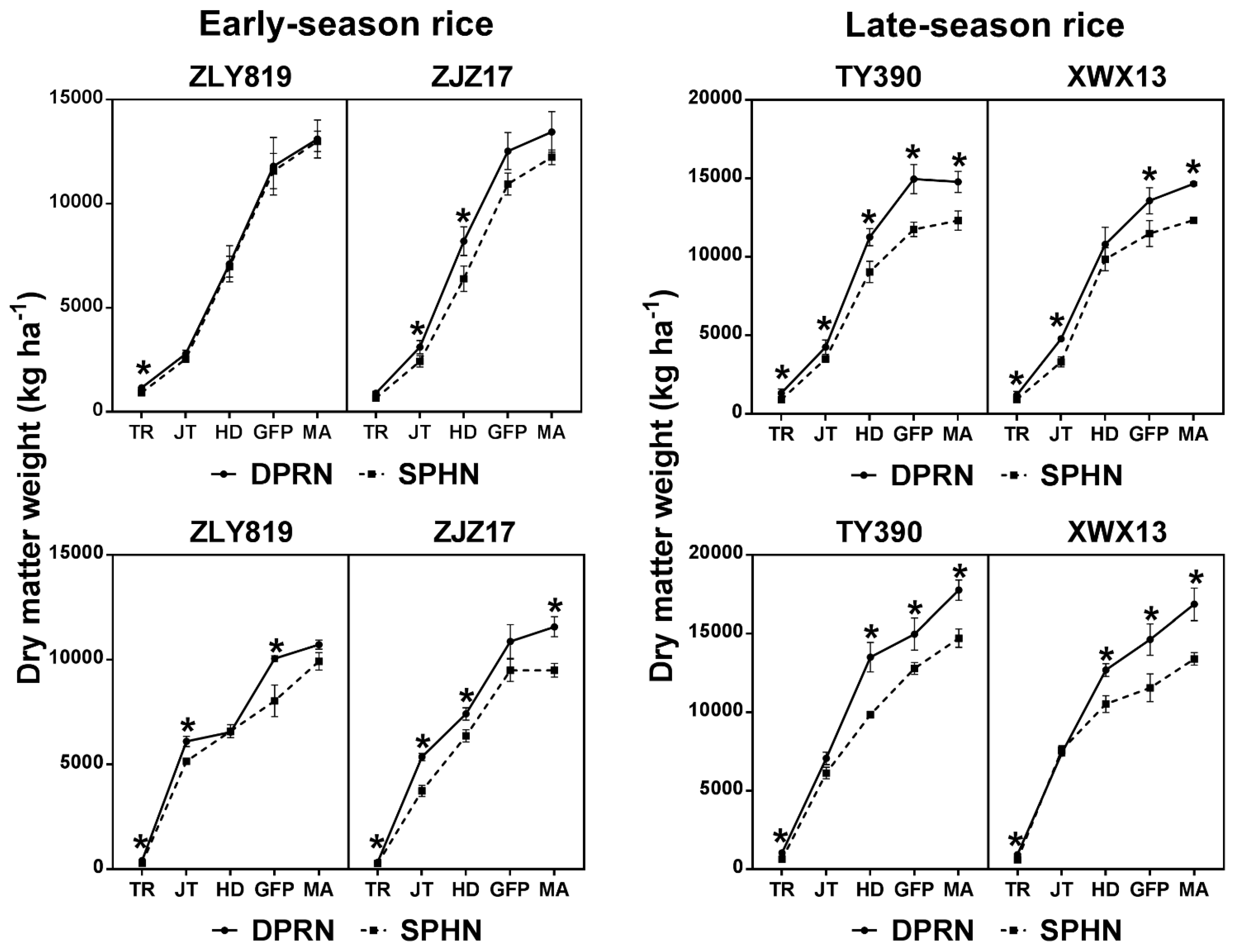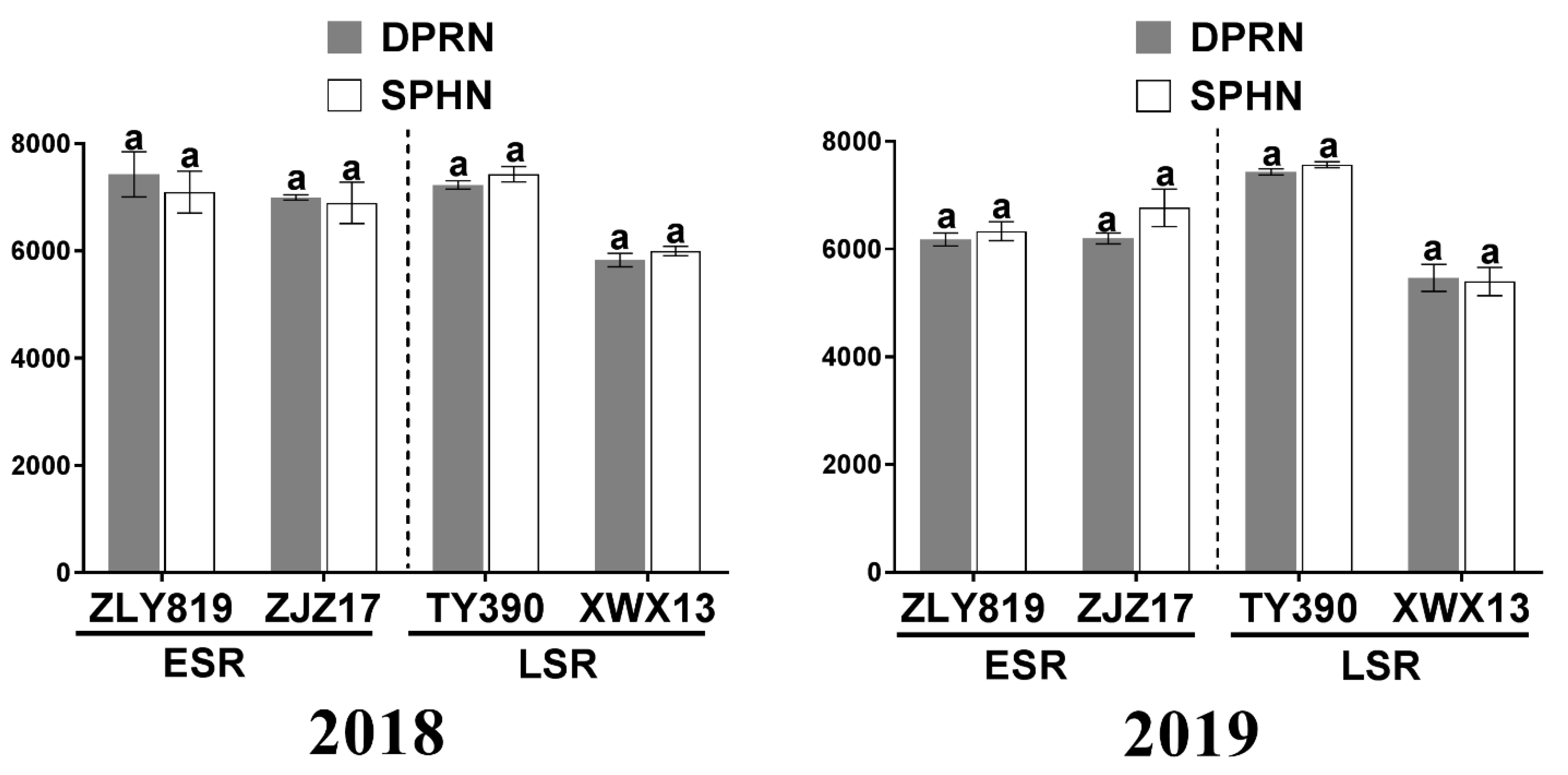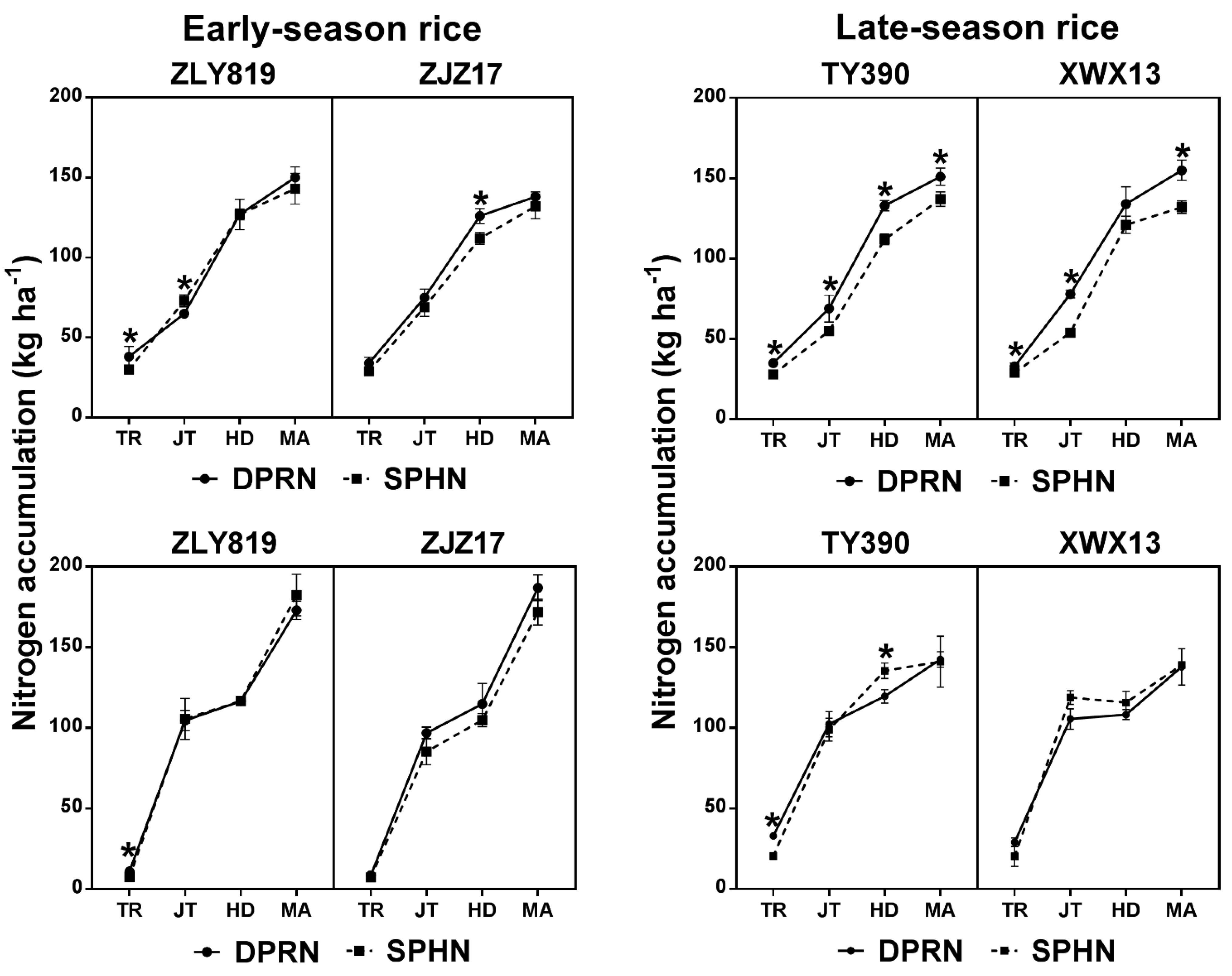Dense Planting with Reducing Nitrogen Rate Increased Nitrogen Use Efficiency and Translocated Nitrogen in Grains in Double-Cropped Rice
Abstract
:1. Introduction
2. Materials and Methods
2.1. Experimental Site
2.2. Experimental Design
2.3. Sampling and Measurement
2.4. Data Analysis
3. Results
3.1. Rice Growth Status and Grain Yield
3.2. Nitrogen Accumulation in Plant and NUE
3.3. Transport and Distribution of Nitrogen in Plants and the Contribution of Nitrogen Fertilizer
4. Discussion
4.1. Study on High Yield for Double-Cropped Rice under the DPRN
4.2. Study on NUE Enhancement in Double-Cropped Rice under the DPRN
4.3. Allocation of Nitrogen Translocation in Rice Plants under the DPRN
5. Conclusions
Supplementary Materials
Author Contributions
Funding
Institutional Review Board Statement
Informed Consent Statement
Data Availability Statement
Acknowledgments
Conflicts of Interest
References
- Zhou, C.; Huang, Y.; Jia, B.; Wang, S.; Wang, Y. Optimization of nitrogen rate and planting density for improving the grain yield of different rice genotypes in northeast China. Agronomy 2019, 9, 555. [Google Scholar] [CrossRef] [Green Version]
- Zhang, H.; Yu, C.; Kong, X.; Hou, D.; Gu, J.; Liu, L.; Wang, Z.; Yang, J. Progressive integrative crop managements increase grain yield, nitrogen use efficiency and irrigation water productivity in rice. Field Crops Res. 2018, 215, 1–11. [Google Scholar] [CrossRef]
- Yin, Y.; Ying, H.; Xue, Y.; Zheng, H.; Zhang, Q.; Cui, Z. Calculating socially optimal nitrogen (N) fertilization rates for sustainable N management in China. Sci. Total Environ. 2019, 688, 1162–1171. [Google Scholar] [CrossRef] [PubMed]
- Peng, S.; Buresh, R.J.; Huang, J.; Zhong, X.; Zou, Y.; Yang, J.; Wang, G.; Liu, Y.; Hu, R.; Tang, Q.; et al. Improving nitrogen fertilization in rice by site-specific N management. A review. Agron. Sustain. Dev. 2010, 30, 649–656. [Google Scholar] [CrossRef]
- Wu, M.; Liu, M.; Liu, J.; Li, W.-T.; Jiang, C.-Y.; Li, Z.-P. Optimize nitrogen fertilization location in root-growing zone to increase grain yield and nitrogen use efficiency of transplanted rice in subtropical China. J. Integr. Agric. 2017, 16, 2073–2081. [Google Scholar] [CrossRef]
- Meng, X.; Li, Y.; Zhang, Y.; Yao, H. Green manure application improves rice growth and urea nitrogen use efficiency assessed using 15 N labeling. Soil Sci. Plant Nutr. 2019, 65, 1–8. [Google Scholar] [CrossRef]
- Ju, C.; Buresh, R.J.; Wang, Z.; Zhang, H.; Liu, L.; Yang, J.; Zhang, J. Root and shoot traits for rice varieties with higher grain yield and higher nitrogen use efficiency at lower nitrogen rates application. Field Crops Res. 2015, 175, 47–55. [Google Scholar] [CrossRef]
- Chu, G.; Chen, S.; Xu, C.; Wang, D.; Zhang, X. Agronomic and physiological performance of indica/japonica hybrid rice cultivar under low nitrogen conditions. Field Crops Res. 2019, 243, 107625. [Google Scholar] [CrossRef]
- Clerget, B.; Bueno, C.; Domingo, A.J.; Layaoen, H.L.; Vial, L. Leaf emergence, tillering, plant growth, and yield in response to plant density in a high-yielding aerobic rice crop. Field Crops Res. 2016, 199, 52–64. [Google Scholar] [CrossRef]
- Zhu, X.; Zhang, J.; Zhang, Z.; Deng, A.; Zhang, W. Dense planting with less basal nitrogen fertilization might benefit rice cropping for high yield with less environmental impacts. Eur. J. Agron. 2016, 75, 50–59. [Google Scholar] [CrossRef]
- Chen, S.; Yin, M.; Zheng, X.; Liu, S.; Chu, G.; Xu, C.; Wang, D.; Zhang, X. Effect of dense planting of hybrid rice on grain yield and solar radiation use in southeastern China. Agron. J. 2019, 111, 1229–1238. [Google Scholar] [CrossRef] [Green Version]
- Kakar, K.; Nitta, Y.; Asagi, N.; Komatsuzaki, M.; Shiotsu, F.; Kokubo, T.; Xuan, T.D. Morphological analysis on comparison of organic and chemical fertilizers on grain quality of rice at different planting densities. Plant. Prod. Sci. 2019, 22, 510–518. [Google Scholar] [CrossRef]
- Chen, Y.; Peng, J.; Wang, J.; Fu, P.; Hou, Y.; Zhang, C.; Fahad, S.; Peng, S.; Cui, K.; Nie, L.; et al. Crop management based on multi-split topdressing enhances grain yield and nitrogen use efficiency in irrigated rice in China. Field Crops Res. 2015, 184, 50–57. [Google Scholar] [CrossRef]
- Xie, X.; Shan, S.; Wang, Y.; Cao, F.; Chen, J.; Huang, M.; Zou, Y. Dense planting with reducing nitrogen rate increased grain yield and nitrogen use efficiency in two hybrid rice varieties across two light conditions. Field Crops Res. 2019, 236, 24–32. [Google Scholar] [CrossRef]
- Stein, L.Y.; Klotz, M.G. The nitrogen cycle. Curr. Biol. 2016, 26, R94–R98. [Google Scholar] [CrossRef] [Green Version]
- Stevens, C.J. Nitrogen in the environment. Science 2019, 363, 578–580. [Google Scholar] [CrossRef] [Green Version]
- Xiao, J.; Wang, Q.; Ge, X.; Zhu, L.; Wu, J. Defining the ecological efficiency of nitrogen use in the context of nitrogen cycling. Ecol. Indic. 2019, 107, 105493. [Google Scholar] [CrossRef]
- Lan, Y.; Sui, X.; Wang, J.; Duan, Q.; Li, T. Effects of nitrogen application rate on protein components and yield of low-gluten rice. Agriculture 2021, 11, 302. [Google Scholar] [CrossRef]
- Zhang, K.; Yang, D.; Greenwood, D.J.; Rahn, C.R.; Thorup-Kristensen, K. Development and critical evaluation of a generic 2-D agro-hydrological model (SMCR_N) for the responses of crop yield and nitrogen composition to nitrogen fertilizer. Agric. Ecosyst. Environ. 2009, 132, 160–172. [Google Scholar] [CrossRef] [Green Version]
- Huang, M.; Yang, C.; Ji, Q.; Jiang, L.; Tan, J.; Li, Y. Tillering responses of rice to plant density and nitrogen rate in a subtropical environment of southern China. Field Crops Res. 2013, 149, 187–192. [Google Scholar] [CrossRef]
- Xie, X.B.; Zhou, X.F.; Jiang, P.; Chen, J.N.; Zou, Y.B. Effect of low nitrogen rate combined with high plant density on grain yield and nitrogen use efficiency in super rice. Acta Agron. Sin. 2015, 41, 1591–1602, (In Chinese with English Abstract). [Google Scholar] [CrossRef]
- Zhang, Y.; Yan, J.; Rong, X.; Han, Y.; Yang, Z.; Hou, K.; Zhao, H.; Hu, W. Responses of maize yield, nitrogen and phosphorus runoff losses and soil properties to biochar and organic fertilizer application in a light-loamy fluvo-aquic soil—ScienceDirect. Agric. Ecosyst. Environ. 2021, 314, 107433. [Google Scholar] [CrossRef]
- Huang, M.; Chen, J.; Cao, F.; Zou, Y. Increased hill density can compensate for yield loss from reduced nitrogen input in machine-transplanted double-cropped rice. Field Crops Res. 2017, 221, 333–338. [Google Scholar] [CrossRef]
- Ao, H.; Peng, S.; Zou, Y.; Tang, Q.; Visperas, R.M. Reduction of unproductive tillers did not increase the grain yield of irrigated rice. Field Crops Res. 2010, 116, 108–115. [Google Scholar] [CrossRef]
- Cao, X.; Zhong, C.; Sajid, H.; Zhu, L.; Zhang, J.; Wu, L.; Jin, Q. Effects of watering regime and nitrogen application rate on the photosynthetic parameters, physiological characteristics, and agronomic traits of rice. Acta Physiol. Plant. 2017, 39, 135. [Google Scholar] [CrossRef]
- Xiong, D.; Wang, D.; Liu, X.; Peng, S.; Huang, J.; Li, Y. Leaf density explains variation in leaf mass per area in rice between cultivars and nitrogen treatments. Ann. Bot. 2016, 117, 963–971. [Google Scholar] [CrossRef] [Green Version]
- Liu, X.-J.; Cao, Q.; Yuan, Z.-F.; Liu, X.; Wang, X.-L.; Tian, Y.-C.; Cao, W.-X.; Zhu, Y. Leaf area index based nitrogen diagnosis in irrigated lowland rice. J. Integr. Agric. 2018, 17, 111–121. [Google Scholar] [CrossRef] [Green Version]
- Zhao, Y.; Xi, M.; Zhang, X.; Lin, Z.; Ding, C.; Tang, S.; Liu, Z.; Wang, S.; Ding, Y. Nitrogen effect on amino acid composition in leaf and grain of japonica rice during grain filling stage. J. Cereal Sci. 2015, 64, 29–33. [Google Scholar] [CrossRef]
- Jing, Q.; Dai, T.; Jiang, D.; Zhu, Y.; Cao, W. Spatial distribution of leaf area index and leaf N content in relation to grain yield and nitrogen uptake in rice. Plant. Prod. Sci. 2007, 10, 136–145. [Google Scholar] [CrossRef]
- Fageria, N.K.; Santos, A.B.; Cutrim, V.A. Dry matter and yield of lowland rice genotypes as influence by nitrogen fertilization. J. Plant Nutr. 2008, 31, 788–795. [Google Scholar] [CrossRef]
- Zheng, H.; Chen, Y.; Chen, Q.; Li, B.; Zhang, Y.; Jia, W.; Mo, W.; Tang, Q. High-density planting with lower nitrogen application increased early rice production in a double-season rice system. Agron. J. 2020, 112, 205–214. [Google Scholar] [CrossRef] [Green Version]
- Zhu, Z.L.; Chen, D.L. Nitrogen fertilizer use in China—Contributions to food production, impacts on the environment and best management strategies. Nutr. Cycl. Agroecosyst. 2002, 63, 117–127. [Google Scholar] [CrossRef]
- Ju, X.-T.; Liu, X.-J.; Pan, J.-R.; Zhang, F.-S. Fate of N-15-labeled urea under a winter wheat-summer maize rotation on the North China Plain. Pedosphere 2007, 17, 52–61. [Google Scholar] [CrossRef]
- Sun, B.; Shen, R.-P.; Bouwman, A.F. Surface N balances in agricultural crop production systems in China for the period 1980–2015. Pedosphere 2008, 18, 304–315. [Google Scholar] [CrossRef]
- Kawachi, T.; Sueyoshi, K.; Nakajima, A.; Yamagata, H.; Sugimoto, T.; Oji, Y. Expression of asparagine synthetase in rice (Oryza sativa) roots in response to nitrogen. Physiol. Plant. 2002, 114, 41–46. [Google Scholar] [CrossRef]
- Ikeda, S.; Sasaki, K.; Okubo, T.; Yamashita, A.; Terasawa, K.; Bao, Z.; Liu, D.; Watanabe, T.; Murase, J.; Asakawa, S. Low Nitrogen Fertilization Adapts Rice Root Microbiome to Low Nutrient Environment by Changing Biogeochemical Functions. Microbes Environ. 2014, 29, 50–59. [Google Scholar] [CrossRef] [Green Version]
- Chien, P.S.; Chiang, C.B.; Wang, Z.; Chiou, T.J. MicroRNA-mediated signaling and regulation of nutrient transport and utilization. Curr. Opin. Plant Biol. 2017, 39, 73–79. [Google Scholar] [CrossRef]
- Li, G.; Hu, Q.; Shi, Y.; Cui, K.; Nie, L.; Huang, J.; Peng, S. Low nitrogen application enhances starch-metabolizing enzyme activity and improves accumulation and translocation of non-structural carbohydrates in rice stems. Front. Plant Sci. 2018, 9, 1128. [Google Scholar] [CrossRef]
- Zhou, W.; Lv, T.; Zhang, P.; Huang, Y.; Chen, Y.; Ren, W. Regular nitrogen application increases nitrogen utilization efficiency and grain yield in Indica hybrid rice. Agron. J. 2016, 108, 1951–1961. [Google Scholar] [CrossRef]
- Xu, L.; Yuan, S.; Wang, X.; Yu, X.; Peng, S. High yields of hybrid rice do not require more nitrogen fertilizer than inbred rice: A meta-analysis. Food Energy Secur. 2021, 10, e276. [Google Scholar] [CrossRef]
- Yoshinaga, I.; Miura, A.; Hitomi, T.; Hamada, K.; Shiratani, E. Runoff nitrogen from a large sized paddy field during a crop period. Agric. Water Manag. 2007, 87, 217–222. [Google Scholar] [CrossRef]
- Berlin, M.; Kumar, G.S.; Nambi, I.M. Numerical modelling on transport of nitrogen from wastewater and fertilizer applied on paddy fields. Ecol. Model. 2014, 278, 85–99. [Google Scholar] [CrossRef]
- Xia, X.; Zhang, S.; Li, S.; Zhang, L.; Wang, G.; Zhang, L.; Wang, J.; Li, Z. The cycle of nitrogen in river systems: Sources, transformation, and flux. Environ. Sci. Processes Impacts 2018, 20, 863–891. [Google Scholar] [CrossRef] [PubMed]




| GY (kg ha−1) | DMW (kg ha−1) | ES m−2 | GS−1 | GW (g) | NUE (%) | |
|---|---|---|---|---|---|---|
| Treatments (T) | 0.73 ns | 15.9 ** | 64.09 ** | 0.01 ns | 0.14 ns | 52.51 ** |
| Rice season (R) | 1.32 ns | 34.67 ** | 8.03 ** | 6.23 * | 0.14 ns | 0.08 ns |
| Cultivar (C) | 37.05 ** | 0.31 ns | 10.24 ** | 0.46 ns | 4.88 * | 0.09 ns |
| T × R | 0.01 ns | 1.96 ns | 7.12 * | 1.06 ns | 0.57 ns | 0.74 ns |
| T × C | 0.02 ns | 1.12 ns | 0.01 ns | 0.03 ns | 0.01 ns | 0.68 ns |
| R × C | 38.49 ** | 0.01 ns | 2.07 ns | 15.92 ** | 3.01 ns | 0.25 ns |
| T × R × C | 0.31 ns | 0.38 ns | 0.18 ns | 0.5 ns | 0.13 ns | 0.05 ns |
| Years | Season | Cultivar | Treatment | NUE (%) | PFPN (kg kg−1) | AEN (kg kg−1) | N Index of Harvest |
|---|---|---|---|---|---|---|---|
| 2018 | ESR | ZLY819 | DPRN−E | 54.6 a | 61.9 a | 28.3 a | 0.76 a |
| SPHN−E | 33.2 b | 47.3 b | 19.8 b | 0.70 a | |||
| ZJZ17 | DPRN−E | 52.4 a | 58.3 a | 25.8 a | 0.75 a | ||
| SPHN−E | 44.2 b | 46.0 b | 21.8 b | 0.65 a | |||
| LSR | TY390 | DPRN−L | 54.3 a | 60.2 a | 14.7 a | 0.69 a | |
| SPHN−L | 32.4 b | 49.5 b | 13.5 a | 0.69 a | |||
| XWX13 | DPRN−L | 49.7 a | 48.6 a | 6.4 b | 0.62 a | ||
| SPHN−L | 31.9 b | 40.0 b | 10.0 a | 0.60 a | |||
| 2019 | ESR | ZLY819 | DPRN−E | 56.8 a | 49.4 a | 15.8 a | 0.69 a |
| SPHN−E | 49.1 b | 42.2 a | 14.0 a | 0.65 a | |||
| ZJZ17 | DPRN−E | 55.6 a | 51.7 a | 15.8 a | 0.68 a | ||
| SPHN−E | 42.9 b | 45.1 a | 17.8 a | 0.67 a | |||
| LSR | TY390 | DPRN−L | 60.5 a | 61.8 a | 17.8 a | 0.71 a | |
| SPHN−L | 48.2 b | 47.7 b | 17.0 a | 0.69 a | |||
| XWX13 | DPRN−L | 59.5 a | 45.6 a | 10.6 a | 0.61 a | ||
| SPHN−L | 47.9 b | 32.7 b | 7.3 a | 0.59 a |
| Season | Cultivar | Treatment | Nitrogen Absorbed before Heading to Spike | Nitrogen Source in Spike at Maturity Stage | ||||
|---|---|---|---|---|---|---|---|---|
| Transferred Proportion (%) | Transferred Amount (kg hm−2) | Transferred Proportion before Heading (%) | Absorbed Proportion after Heading (%) | Transferred Amount before Heading (kg hm−2) | Absorbed Amount after Heading (kg hm−2) | |||
| ESR | ZLY819 | DPRN−E | 68.9 | 73.1 | 69.5 | 30.5 | 80.5 | 35.3 |
| SPHN−E | 65.1 | 66.7 | 62.9 | 37.1 | 75.5 | 44.4 | ||
| ZJZ17 | DPRN−E | 76.4 | 64.2 | 65.7 | 34.3 | 70.6 | 36.9 | |
| SPHN−E | 74.4 | 60.5 | 53.0 | 47.0 | 67.6 | 59.9 | ||
| LSR | TY390 | DPRN−L | 65.8 | 61.3 | 66.9 | 33.1 | 67.4 | 33.3 |
| SPHN−L | 58.6 | 55.3 | 57.6 | 42.4 | 60.8 | 44.7 | ||
| XWX13 | DPRN−L | 59.9 | 57.5 | 77.7 | 22.3 | 63.3 | 18.2 | |
| SPHN−L | 50.3 | 53.4 | 70.3 | 29.7 | 59.8 | 25.2 | ||
| Maturity | Before Heading | After Heading | ||||||
|---|---|---|---|---|---|---|---|---|
| Season | Cultivar | Treatment | Proportion of Nitrogen Fertilizer (%) | Amount of Nitrogen Fertilizer (kg hm−2) | Proportion of Nitrogen Fertilizer (%) | Amount of Nitrogen Fertilizer (kg hm−2) | Proportion of Nitrogen Fertilizer (%) | Amount of Nitrogen Fertilizer (kg hm−2) |
| ESR | ZLY819 | DPRN−E | 52.3 a | 87.6 a | 58.6 a | 68.1 a | 38.1 a | 19.5 a |
| SPHN−E | 54.1 a | 79.1 a | 56.4 a | 58.8 a | 45.1 a | 20.3 a | ||
| ZJZ17 | DPRN−E | 39.7 a | 72.1 a | 52.3 a | 50.7 a | 25.0a | 17.3 a | |
| SPHN−E | 45.2 a | 64.4 a | 56.7 a | 48.2 a | 24.8 a | 16.2 a | ||
| LSR | TY390 | DPRN−L | 47.0 b | 76.9 a | 52.5 b | 60.5 a | 31.4 b | 16.4 a |
| SPHN−L | 60.0 a | 79.5 a | 59.0 a | 65.2 a | 33.8 a | 14.3 a | ||
| XWX13 | DPRN−L | 48.1 b | 71.4 a | 49.1 b | 55.8 a | 39.7 b | 15.6 a | |
| SPHN−L | 60.5 a | 84.2 a | 56.4 a | 71.2 a | 45.2 a | 13.0 a | ||
Publisher’s Note: MDPI stays neutral with regard to jurisdictional claims in published maps and institutional affiliations. |
© 2022 by the authors. Licensee MDPI, Basel, Switzerland. This article is an open access article distributed under the terms and conditions of the Creative Commons Attribution (CC BY) license (https://creativecommons.org/licenses/by/4.0/).
Share and Cite
Luo, Z.; Song, H.; Huang, M.; Zhang, Z.; Peng, Z.; Yang, Z.; Shen, T.; Luo, G. Dense Planting with Reducing Nitrogen Rate Increased Nitrogen Use Efficiency and Translocated Nitrogen in Grains in Double-Cropped Rice. Agronomy 2022, 12, 1090. https://doi.org/10.3390/agronomy12051090
Luo Z, Song H, Huang M, Zhang Z, Peng Z, Yang Z, Shen T, Luo G. Dense Planting with Reducing Nitrogen Rate Increased Nitrogen Use Efficiency and Translocated Nitrogen in Grains in Double-Cropped Rice. Agronomy. 2022; 12(5):1090. https://doi.org/10.3390/agronomy12051090
Chicago/Turabian StyleLuo, Zhuo, Haixing Song, Min Huang, Zhenhua Zhang, Zhi Peng, Zhichang Yang, Tao Shen, and Gongwen Luo. 2022. "Dense Planting with Reducing Nitrogen Rate Increased Nitrogen Use Efficiency and Translocated Nitrogen in Grains in Double-Cropped Rice" Agronomy 12, no. 5: 1090. https://doi.org/10.3390/agronomy12051090
APA StyleLuo, Z., Song, H., Huang, M., Zhang, Z., Peng, Z., Yang, Z., Shen, T., & Luo, G. (2022). Dense Planting with Reducing Nitrogen Rate Increased Nitrogen Use Efficiency and Translocated Nitrogen in Grains in Double-Cropped Rice. Agronomy, 12(5), 1090. https://doi.org/10.3390/agronomy12051090









